Anions(Non-suppressor Method: I-524A Column)
Anion standards were analyzed using IC I-524A. A phthalic acid eluent is recommended for the general analysis. Most of the important anions such as F–or H2PO4–, Cl–, NO2–, Br–, NO3– and SO42- can be analyzed with this eluent. Therefore, it is suitable for the routine analysis of anions.

Sample : 20micro-L
1. H2PO4– 30mg/L
2. Cl– 5mg/L
3. NO2– 10mg/L
4. Br– 10mg/L
5. NO3– 10mg/L
6. SO42- 10mg/L
Column : Shodex IC I-524A (4.6mmID*100mm) Eluent : 2.5mM Phthalic acid + 2.3mM Tris(hydroxymethyl)aminomethane aq. Flow rate : 1.2mL/min Detector : Non-suppressed coductivity Column temp. : 40deg-C
Anion standards were analyzed using IC I-524A. A phthalic acid eluent is recommended for Anion analysis. Phosphoric ion has almost no response with this eluent.

Sample : 40micro-L
1. F– 5mg/L
2. Cl– 5mg/L
3. NO2– 5mg/L
4. Br– 10mg/L
5. NO3– 15mg/L
6. SO42- 10mg/L
7. S2O32- 10mg/L
8. I– 20mg/L
9. SCN– 20mg/L
Column : Shodex IC I-524A (4.6mmID*100mm) Eluent : 2.5mM Phthalic acid + 2.9mM Tris(hydroxymethyl)aminomethane aq. Flow rate : 1.2mL/min Detector : Non-suppressed coductivity Column temp. : 40deg-C
Anion standards were analyzed using IC I-524A. This eluent is suitable for the separation of ions that elute before chloride. After each sample is analyzed, it is necessary to wash the column with 200 to 300micro-L of 0.1M tartaric acid when the sample contains NO3–, SO42-, etc. because they elute very slowly and may be remaining inside the column.

Sample : 10mg/L each, 50micro-L
1. Acetic acid
2. H2PO4–
3. H2PO2–
4. H2PO3–
5. ClO2–
6. BrO3–
7. Cl–
Column : Shodex IC I-524A (4.6mmID*100mm) Eluent : 1mM Tartaric acid aq. Flow rate : 1.2mL/min Detector : Non-suppressed coductivity Column temp. : 40deg-C
Anion standards were analyzed using IC I-524A. By adding boric acid to the phthalic acid, phosphoric ion (H2PO4-) and fluoride ion (F–) can be separated.
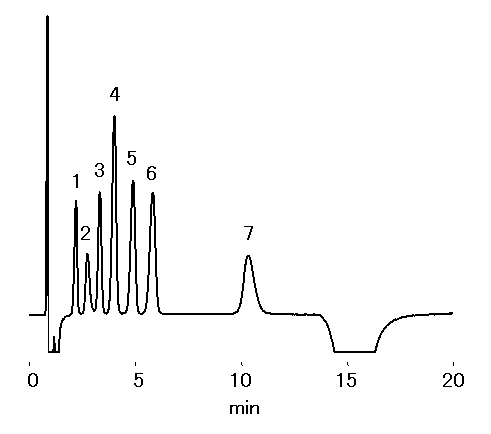
Sample : 100micro-L
1. H2PO4– 10mg/L
2. F– 1mg/L
3. Cl– 1mg/L
4. NO2– 5mg/L
5. Br– 5mg/L
6. NO3– 5mg/L
7. SO42- 5mg/L
Column : Shodex IC I-524A (4.6mmID*100mm) Eluent : 2.0mM Phthalic acid + 1.84mM Tris(hydroxymethyl)aminomethane + 300mM Boric acid aq. Flow rate : 1.2mL/min Detector : Non-suppressed coductivity Column temp. : 40deg-C
Anion standards were analyzed using IC I-524A. The concentration of phthalic acid is lower than that of Anion Standards (6) (I-524A). This eluent condition is suited to the separation of anions and organic acids.
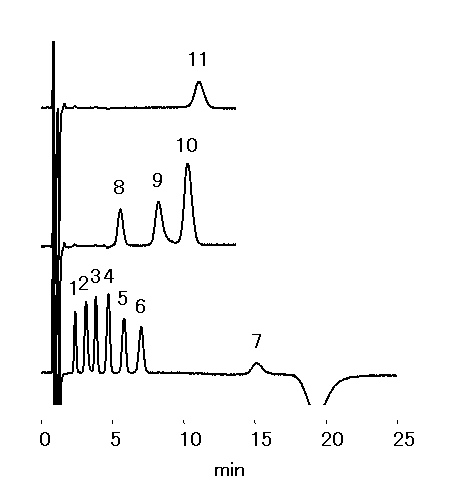
Sample : 30micro-L
1. H2PO4– 20mg/L
2. F– 2.5mg/L
3. Cl– 2.5mg/L
4. NO2– 5mg/L
5. Br– 5mg/L
6. NO3– 5mg/L
7. SO42- 5mg/L
8. Malic acid 20mg/L
9. Oxalic acid 20mg/L
10. Fumaric acid 20mg/L
11. Citric acid 20mg/L
Column : Shodex IC I-524A (4.6mmID*100mm) Eluent : 1.5mM Phthalic acid + 1.38mM Tris(hydroxymethyl)aminomethane + 300mM Boric acid Flow rate : 1.2mL/min Detector : Non-suppressed coductivity Column temp. : 40deg-C
Anion standards were analyzed using IC I-524A. A mixture of octanesulfonic acid and boric acid is used as the eluent. This eluent is good for obtaining a low background and a stable baseline even when a large quantity of sample is injected. Therefore, it is suited for low concentration samples. No system peak will appear with this eluent.
(Preparation of eluent)
Put 0.195g of reagent grade sodium octanesulfonic acid and 1.22g of reagent grade boric acid into a messflask and dilute with pure water to make up a 1 liter solution and dissolve it using an ultrasonic vibrator.
Refer to High Sensitive Detection Method for Anions.

Sample :
1. F–
2. Cl–
3. NO2–
4. Br–
5. NO3–
6. I–
7. SO42-
8. S2O32-
Column : Shodex IC I-524A (4.6mmID*100mm) Eluent : 0.9mM Sodium 1-octanesulfonate + 20mM Boric acid(pH5.3) Flow rate : 1.2mL/min Detector : Non-suppressed coductivity Column temp. : 40deg-C
Anion standards were analyzed using IC I-524A. This eluent is suited to the separation of three kinds of acids, phosphoric acid(H2PO4–), pyrophosphoric acid(H2P2O72-) and tripolyphosphoric acid(H3P3O102-). EDTA-2Na is added to prevent the complexation of ferrous ion with polyphosphoric acids.

Sample :
1. H2PO4–
2. H2P2O72-
3. H3P3O102-
Column : Shodex IC I-524A (4.6mmID*100mm) Eluent : 3mM Trimesic acid + 0.04mM EDTA-2Na(pH3.3) Flow rate : 1.2mL/min Detector : Non-suppressed coductivity Column temp. : 40deg-C
Anion standards were analyzed using IC I-524A. This figure shows the effect of pH on retention time with a 2.5mM phthalic acid eluent. Generally, the retention time decreases with the increase of pH. A sharp peak of MoO42- cannot be obtained below pH5.0, neither CrO42- below pH6.0, nor H2PO4– can be obtained above pH4.2 or F– above pH4.5.

Sample :
Br–
Cl–
F–
I–
NO3–
NO2–
ClO4–
H2PO4–
SO42-
SCN–
S2O32-
MoO42-
CrO42-
Column : Shodex IC I-524A (4.6mmID*100mm) Eluent : 2.5mM Phthalic acid(pH variable) Flow rate : 1.2mL/min Detector : Non-suppressed coductivity Column temp. : 40deg-C
Anion standards were analyzed using IC I-524A. This figure shows the change in dynamic range of the column with the peak height. There is a linearity in the 0.1 to 10mg/L range for F– and in the 0.1 to 100mg/L range for SO42- when the injection volume is 100micro-L.

Column : Shodex IC I-524A (4.6mmID*100mm) Eluent : 2.5mM Phthalic acid(pH4.0 adjusted by Tris(hydroxymethyl)aminomethane) Flow rate : 1.2mL/min Detector : Non-suppressed coductivity Column temp. : 40deg-C
Anion standards were analyzed using IC I-524A. This shows the change in column efficiency with the concentration of the sample when the injection volume is 100micro-L. The column efficiency does not decrease until the sample concentration reaches 10mg/L for Cl– and 100mg/L for SO42-. Beyond those concentrations, HETP increases and peak becomes broad. When 1mg/L of Cl– is injected, there is not decreasing in column efficiency until the injection volume reaches 500micro-L.

Sample :
Cl–
SO42-
HETP=(Column length)/(Theoretical plate number)
Column : Shodex IC I-524A (4.6mmID*100mm) Eluent : 2.5mM Phthalic acid(pH4.0 adjusted by Tris(hydroxymethyl)aminomethane) Flow rate : 1.2mL/min Detector : Non-suppressed coductivity Column temp. : 40deg-C
| Regulations for water supply introduced on April, 2004 |
||
|---|---|---|
| Item | Criteria value | Usable method |
| Nitrate nitrogen & Nitrite nitrogen |
10mg/L or less
|
Ion chromatography
|
| Fluoride |
0.8mg/L or less
|
Ion chromatography |
| Chloride |
200mg/L or less
|
Ion chromatography or Titrimetric method |
Anions in tap water were analyzed using IC I-524A. Since phosphoric ion is not present in this sample, F–, Cl–, NO3– and SO42- can be separated in a short time without t he interference of phosphoric ion peak using this eluent. When both F– and H2PO4– are present, they cannot be separated each othe with this analysis conditionr.
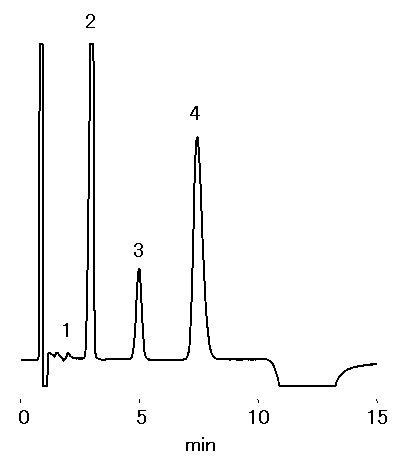
Sample : Tap water (Water), 100micro-L
1. F–
2. Cl–
3. NO3–
4. SO42-
Column : Shodex IC I-524A (4.6mmID*100mm) Eluent : 2.5mM Phthalic acid + 2.3mM Tris(hydroxymethyl)aminomethane aq. Flow rate : 1.2mL/min Detector : Non-suppressed coductivity Column temp. : 40deg-C
Based on the method described in the Japanese regulation for water supply, anions were analyzed using IC I-524A.
Please refer to ‘Regulation for Water Supply‘.

Sample : 100micro-L each
Anion standards
1. H2PO4– 10mg/L
2. F– 1mg/L
3. Cl– 1mg/L
4. NO2– 5mg/L
5. Br– 5mg/L
6. NO3– 5mg/L
7. SO42- 5mg/L
Tap water (Water)
2. F–
3. Cl–
6. NO3–
7. SO42-
Column : Shodex IC I-524A (4.6mmID*100mm) Eluent : 2.0mM Phthalic acid + 1.84mM Tris(hydroxymethyl)aminomethane + 300mM Boric acid aq. Flow rate : 1.2mL/min Detector : Non-suppressed coductivity Column temp. : 40deg-C
Anions in river water were analyzed using IC I-524A. In river water, small volume of H2PO4–, Br– and NO2– as well as Cl–, NO3– and SO42- are present. This eluent can be used to separate H2PO4– and F–.

Sample : 100micro-L each
Anion standards
1. H2PO4– 10mg/L
2. F– 1mg/L
3. Cl– 1mg/L
4. NO2– 5mg/L
5. Br– 5mg/L
6. NO3– 5mg/L
7. SO42- 5mg/L
5-fold diluted
River water (Water)
1. H2PO4–
3. Cl–
4. NO2–
5. Br–
6. NO3–
7. SO42-
Column : Shodex IC I-524A Eluent : 2.0mM Phthalic acid + 1.84mM Tris(hydroxymethyl)aminomethane + 300mM Boric acid aq. Flow rate : 1.2mL/min Detector : Non-suppressed coductivity Column temp. : 40deg-C
Figures in the parentheses are the minimum sample concentration when 500 micro-L of sample is injected.
When the pH of the eluent is larger than 4.5, phosphoric ion is detected as a negative peak.
(Preparation of eluent)
1) Put 0.195g of reagent grade sodium 1-octanesulfonate and 1.22g of reagent grade boric acid into a messflask.
2) Dilute with purified water to make up a 1 liter solution.
3) Dissolve using an ultrasonic vibrator.
4) Pass through a 0.2micro-m membrane filter before use.
| Detection sensitivity | ||
|---|---|---|
| NO2– |
1.0ng
|
(2 micro-g/L)
|
| NO3– |
1.0ng
|
(2 micro-g/L)
|
| SO42- |
1.5ng
|
(3 micro-g/L)
|
Please refer to ‘Anion Standards (8) (Eluent : Octanesulfonic Acid and Boric Acid) ‘.
Standard anions (F–, Cl–, NO2–, Br–, NO3–, HPO42- and SO42-) as well as carbonate were analyzed using IC I-524A. When an alkaline eluent is used, peaks of divalent cations (Mg2+, Ca2+) may interfere. In such instances, the sample must be pretreated using an Na+ type cation exchanger and the divalent cations in the sample replaced with Na+.
In case that the pH of the eluent is higher than 7.0, 10% methanol should be added to maintain the durability of the packing material.
(Preparation of eluent)
1) Put 0.207g of reagent grade p-hydroxybenzoic acid and 100mL of methanol into a messflask and dissolve.
2) Add pure water to make up a 900mL solution.
3) Add 7.9mL of 0.2M reagent grade diethylethanolamine.
4) Add purified water to make up a 1 liter solution.
5) Pass through a 0.2micron membrane filter before use.
(Remark): 0.2M diethylethanolamine should be kept in a refrigerator.

Sample :
1. F–
2. HCO3–
3. Cl–
4. NO2–
5. Br–
6. NO3–
7. HPO42-
8. SO42-
AsO43-
I–
CrO42-
S2O32-
WO42-
MoO42-
SCN–
Column : Shodex IC I-524A (4.6mmID*100mm) Eluent : 1.5mM p-Hydroxybenzoic acid(pH7.8 adjusted with N,N-Diethylethanolamine) + 10% CH3OH Flow rate : 1.2mL/min Detector : Non-suppressed coductivity Column temp. : 40deg-C
This chromatogram shows a data of analysis of standard anions using IC I-524A with an alkaline eluent. When the pH of the eluent is higher than 7.0, 10% methanol should be added to maintain the durability of the packing material.

Sample : 10mg/L each, 100micro-L
1. SO42-
2. SO32-
3. S2O32-
4. SCN–
Column : Shodex IC I-524A (4.6mmID*100mm) Eluent : 0.25mM p-Hydroxybenzoic acid + 1.2mM N,N-Diethylethanolamine + 10% CH3OH Flow rate : 1.5mL/min Detector : Non-suppressed coductivity Column temp. : 50deg-C
Polythionate(SO42-, SO32-, etc.) can be analyzed using IC I-524A. What the pH of the eluent is higher than 7.0, 10% methanol should be added to maintain the durability of the packing material.
(Preparation of eluent)
Put 0.345g of reagent grade p-hydroxybenzoic acid and 100mL of methanol into a 1 liter messflask and dissolve; adjusted with 0.2M reagent grade diethylethanolamine and add pure water to make up a 1 liter solution.

Sample :
1. SO42-
2. S2O32-
3. S3O62-
4. S4O62-
Column : Shodex IC I-524A (4.6mmID*100mm) Eluent : 2.5mM p-Hydroxybenzoic acid(pH9.7 adjusted with N,N-Diethylethanolamine) + 10% CH3OH Flow rate : 1.2mL/min Detector : Non-suppressed coductivity Column temp. : 40deg-C
The eluent used here is suitable for the simultaneous analysis of inorganic anions and dibasic and tribasic organic acids using IC I-524A. Organic acids are contained in beer and they interfere with the quantification of anions. Cl–, NO3– and SO42- can be separated without such interference of organic acids. Organic acids, oxalic acid and citric acid also can be analyzed without interference.

Sample : 10-fold diluted Beer, 100micro-L
1. Acetic acid
2. H2PO4–, Succinic acid, Pyroglutamic acid
3. Lactic acid, Pyruvic acid
4. Cl–
5. Malic acid, Br–
6. NO3–
7. Oxalic acid
8. Citric acid
9. SO42-
Column : Shodex IC I-524A (4.6mmID*100mm) Eluent : 1.5mM Phthalic acid + 1.38mM Tris(hydroxymethyl)aminomethane + 300mM Boric acid aq. Flow rate : 1.2mL/min Detector : Non-suppressed coductivity Column temp. : 40deg-C
Anions of chinese cabbage are analyzed using IC I-524A. Anions in the sample were extracted using a juicer-mixer and then filtered.
(Preparation of eluent)
(1) Put 0.415g of reagent grade phthalic acid and 0.278g of reagent grade tris(hydroxymethyl)aminomethane into a 1liter messflask.
(2) Dilute with purified water to make up a 1 liter solution.
(3) Dissolve using an ultrasonic vibrator.
(4) Pass through a 0.2microm membrane filter before use.

Sample : Chinese cabbage
(A); Leaves, (B); Stalks
1. H2PO4–
2. Cl–
3. NO3–
4. SO42-
Column : Shodex IC I-524A (4.6mmID*100mm) Eluent : 2.5mM Phthalic acid (pH4.0 adjusted by Tris(hydroxymethyl)aminomethane) Flow rate : 1.2mL/min Detector : Non-suppressed coductivity
Iodic ion in urine is analyzed using IC I-524A and electrochemical detector (ECD).

Sample : Urine diluted10-fold, 100micro-L
I–
Column : Shodex IC I-524A (4.6mmID*100mm) Eluent : 100mM NaH2PO4 + 5mM Ethylenediamine(pH5.9) Flow rate : 1.0mL/min Detector : ECD (Silver electrode, 60mV SCE) Column temp. : 40deg-C
Pure water made by a commercially available water purifier is analyzed using IC I-524A.

Sample : Purifed water (Water)
1. Cl–
2. NO2–
3. NO3–
4. SO42-
Column : Shodex IC I-524A (4.6mmID*100mm) Eluent : 0.9mM Sodium 1-ctanesulfonate + 20mM Boric acid(pH4.6) Flow rate : 1.2mL/min Detector : Non-suppressed coductivity Column temp. : 40deg-C
Anions in milk were analyzed using IC I-524A. Milk contains a considerable amount of proteins and fats, and therefore should be pretreated. 100-fold dilution with pure water was made and then treated by an solid phase extraction cartridge for reversed phase chromatography.

Sample : 100-fold diluted Milk, 50micro-L
2. HCO3–
3. Cl–
6. NO3–
7. HPO42-
Sample : Anion Standards, 50micro-L
1. F- 5mg/L
2. HCO3–30mg/L
3. Cl–5mg/L
4. NO2– 5mg/L
5. Br– 10mg/L
6. NO3– 10mg/L
7. HPO42-10mg/L
8. SO42- 10mg/L
Column : Shodex IC I-524A (4.6mmID*100mm) Eluent : 1.5mM p-Hydoxybenzoic acid + 1.7mM N,N-Diethylethanolamine + 10% CH3OH Flow rate : 1.5mL/min Detector : Non-suppressed coductivity Column temp. : 40deg-C
Anions in sea water were analyzed using IC I-524A. Since sea water contains a considerable amount of chloride ion, the chlorine should be removed prior to analysis. Put Ag-type cation exchanger in a disposable syringe and pass the sea water through the syringe. After the pretreatment, other anions can be analyzed without the interference from chloride ion.
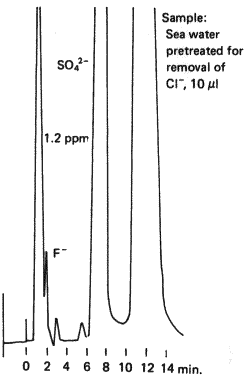
Sample : Sea water (Water)
1.F–
2.SO42-
Column : Shodex IC I-524A (4.6mmID*100mm) Eluent : 2.5mM Phthalic acid(pH4.0 adjusted with Tris(hydroxymethyl)aminomethane) Flow rate : 1.2mL/min Detector : Non-suppressed coductivity Column temp. : 40deg-C
Sodium azide was analyzed using IC I-524A (a column for anions analysis).

Sample : 50micro-L
1. Cl– 2mg/L
2. N3–, Azide 20mg/L
Column : Shodex IC I-524A (4.6mmID*100mm) Eluent : 2.5mM Phthalic acid + 2.9mM Tris(hydroxymethyl)aminomethane Flow rate : 1.2mL/min Detector : Non-suppressed coductivity Column temp. : 40deg-C
Lithium Tetrafluoroborate was analyzed by ion chromatography (anion) column, IC I-524A.
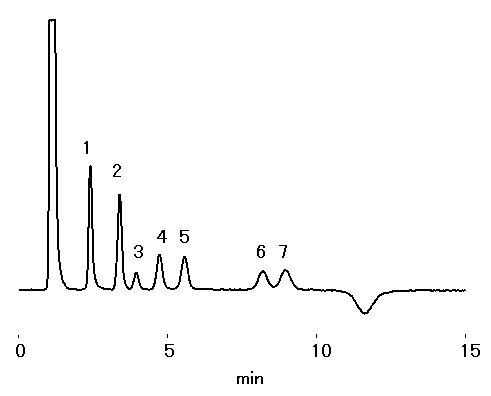
Sample : 10mg/L each, 10micro-L
1. F–
2. Cl–
3. NO2–
4. Br–
5. NO3–
6. BF4–
7. SO42-
Column : Shodex IC I-524A (4.6mmID*100mm) Eluent : 2.5mM Phthalic acid(pH4.0 adjusted by Tris(hydroxymethyl)aminomethane) Flow rate : 1.0mL/min Detector : Non-suppressed coductivity Column temp. : 40deg-C
